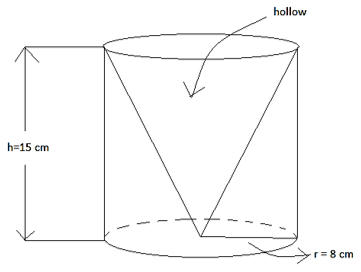From a solid cylinder whose height is 15 cm and diameter 16 cm, a conical cavity of the same height and same diameter is hollowed out. Find the total surface area of the remaining solid. [Use π = 3.14.]
after removing the conical solid the cylinder would look like this

Given: height of cylinder = height of cone = h = 15 cm
Diameter of cylinder = diameter of base cone = 16 cm
∴ radius of cylinder = radius of base of cone = 16/2 = r = 8 cm
Formula: total surface area of cylinder = 2πr2 + πrh
Total surface area of cone = πrl + πr2
Where l is the slant height
l = √(r2 + h2)
l = √(82 + 152)
l = √289
l = 17 cm
In the solid as seen in figure we have the curved surface of cylinder and the base of cylinder as there is no top circular face of the cylinder we should subtract its area from total surface area of cylinder
Area of top circular surface of cylinder = πr2
∴ surface area of cylinder in solid = 2πr2 + πrh - πr2
= πr2 + πrh
= 3.14 × 8 × (8 + 15)
= 3.14 × 8 × 23
= 577.76 cm2
Now there is a hollow conical part with no base of the cone as seen in the figure therefore we should subtract the surface area of base of cone from the total surface area of cone
Surface area of base of cone = πr2
∴ Surface area of conical part in solid = πrl + πr2 - πr2
= πrl
= 3.14 × 8 × 17
= 427.04 cm2
Therefore total surface area of solid = surface area of cylinder in solid + surface area of
conical part in solid
= 577.76 + 427.04
= 1004.8 cm2
Surface area of solid = 1004.8 cm2